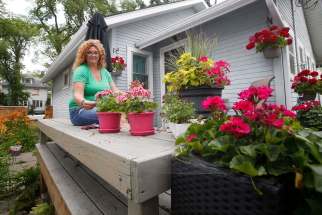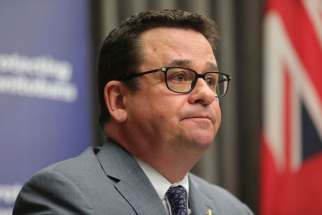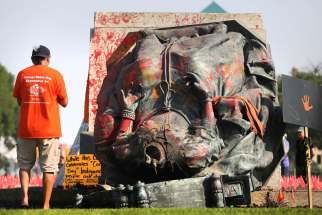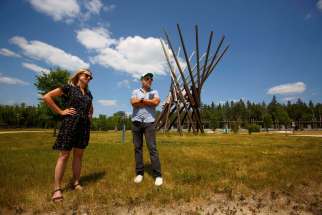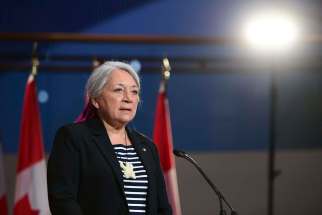Destructive by design Pallister's version of settlement history blind to pain, injustice
Read this article for free:
or
Already have an account? Log in here »
To continue reading, please subscribe:
Monthly Digital Subscription
$1 per week for 24 weeks*
- Enjoy unlimited reading on winnipegfreepress.com
- Read the E-Edition, our digital replica newspaper
- Access News Break, our award-winning app
- Play interactive puzzles
*Billed as $4 plus GST every four weeks. Offer only available to new and qualified returning subscribers. Cancel any time.
Read unlimited articles for free today:
or
Already have an account? Log in here »
Hey there, time traveller!
This article was published 08/07/2021 (1335 days ago), so information in it may no longer be current.
In the wake of protesters hauling down statues of Queen Victoria and Queen Elizabeth outside the Manitoba legislature on Canada Day, Premier Brian Pallister wanted to talk about “building.” That was the word he leaned on Wednesday in his opening remarks at a news conference that was otherwise about the future of Manitoba’s public health orders.
Tearing down the statues was “the wrong choice,” Pallister said, instead of “building together.” To illustrate his point, to respond to this visible expression of Indigenous pain, grief and anger, the premier chose not to name the source of that pain, but rather to make an example of the efforts of European settlers.
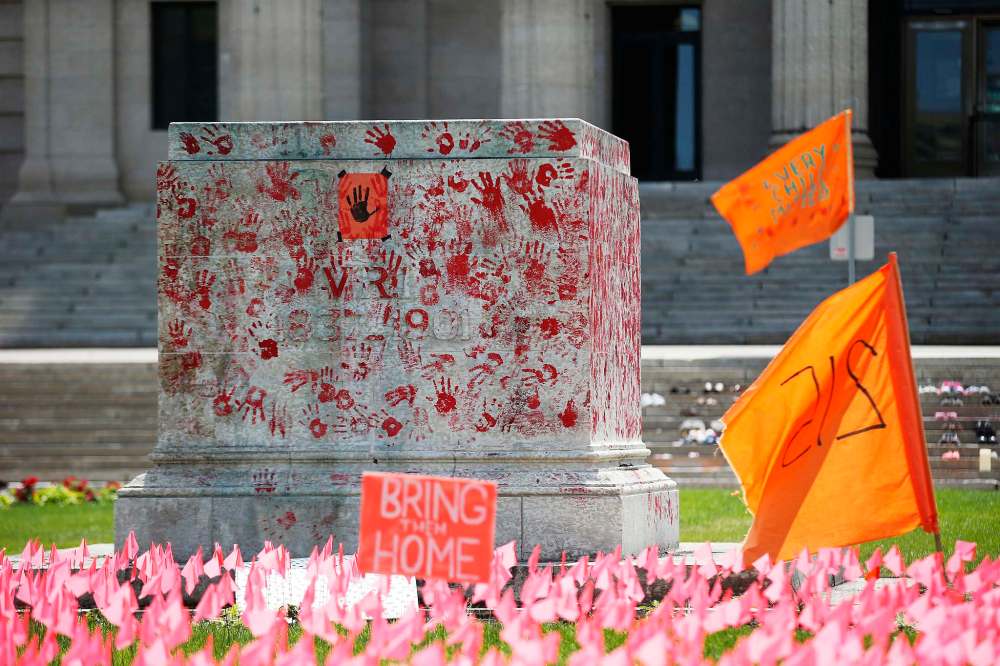
“The people who came to this country, before it was a country and since, didn’t come here to destroy anything,” Pallister said. “They came to build better… They built farms, and they built businesses. They built communities and churches too. And they built these things for themselves, and for one another.”
This idea, about the things settlers built for themselves serving as an example to us today, does make a point, but not the one the premier intended. Because Canada did build itself many things, but never, when it came to Indigenous people, did it build “together,” and what it built was certainly not without destruction.
The premier mentioned farms. So let’s consider how some of those farms came into the hands of settlers.
Here is one such example. About 140 years ago, the area around Selkirk was home to what was then called the St. Peter’s Band, descendants of a group of Anishinaabe led by Chief Peguis, who had signed an early treaty to secure their community in the nooks of the Red River.
Brian Pallister’s comments at a news conference Wednesday:
I want to make some comments in respect to the events of Canada Day.
We all understand, and we should understand, that tearing down is a lot simpler than building up. But building up is what we have to dedicate ourselves to. And I believe that Canada has been, and will always be, I hope, a nation that is an example to those around the world of our dedication to building, to building something better. We are not a perfect country, but we’re a lot closer than a lot of other countries to being perfect, and we need to dedicate ourselves to that construction project that is Canada.
I want to make some comments in respect to the events of Canada Day.
We all understand, and we should understand, that tearing down is a lot simpler than building up. But building up is what we have to dedicate ourselves to. And I believe that Canada has been, and will always be, I hope, a nation that is an example to those around the world of our dedication to building, to building something better. We are not a perfect country, but we’re a lot closer than a lot of other countries to being perfect, and we need to dedicate ourselves to that construction project that is Canada.
I would say to those who are choosing to tear down right now, rather than to build up, that that is the wrong choice. I would say to them, let us build together. That is the right choice. Throughout our country’s history, well before we were acknowledged as a country, we were a home of hope to people from around the world, who came from long distances away to pursue a better life for themselves, for their families. And we continue to be that beacon of light for people from around the world. We must be that beacon of light for our Indigenous people in this country, as well. For too long that has not been the case.
The people who came to this country, before it was a country and since, didn’t come here to destroy anything. They came to build. They came to build better. To build, they did. They built farms, and they built businesses. They built communities, and churches too. And they built these things for themselves, and for one another, and they built them with dedication and with pride. And so, we must dedicate ourselves to building as well, and yet again. Because what these people have done, our ancestors, is they’ve given us a heritage. And heritage is a complicated thing. There are good and bad aspects to Canada’s heritage, as there are to any country’s heritage. We had ups and downs in our country. We’ve had good times, and we’ve had bad moments. And Canada Day was one of those bad moments.
But we need to respect our heritage, just as we need to respect one another. Not to find fault, not to tear down, not to highlight every failure, but rather to realize we are a complex country as we are made up of complex people. And so, our failures should not be celebrated, but they should not be repeated, either. There were failures of character on display the other day that need not be repeated. And that are not helpful, and, in fact, are most unhelpful to the struggle for real building and real reconciliation that must be pursued. The truth is what happened in the past, and the truth is coming out on important issues. But reconciliation is what we can make happen in the future, just as we’ve been dedicated as a government to working on reconciliation projects since we came to government.
Canada is a land of hope. Manitoba is the special heart of Canada. We continue to draw people here, to this centre of our beautiful country, because we are focused on building that hope. We can do better here. You can do better here. You just have to have the will. Here in Canada, and here in Manitoba, we have more tools to build than most people on this planet are given. Tools like public education, and available free health care. These tools and others are important, but they require the will of people to go beyond the basic tools they are given and do something with them. It takes a negative will to tear down. It takes a positive will to build up. And we need to focus on building up. We need to equip all our citizens with more skills. But they need to dedicate themselves as well to building those skills for themselves. We need to help people but people also to have the will also to use the tools they are given.
And in this country we provide through the contributions of our fellow citizens, taxpayers, our friends, our neighbours, the ones who work hard to pay their taxes. We are given the opportunity that so many people around the planet do not have to develop skills, and to earn an income and to become self-sufficient people, and to have the opportunity to build and grow, and so many people do that. So many immigrants to Canada, so many people achieve tremendous success. Our country is known as a country that allows people to move from challenging economic circumstances and find success better than most other countries in the world. Some articles I’ve read say we’re three times as likely to be able, as citizens of Canada, to move from a lower socio-economic category to a middle-income or higher-income category than citizens of the United States are, just an hour to the south.
These are real opportunities. They’re opportunities we need to build on together. We pay for health care, we pay for education, we pay for each other, because we want this to be the home of hope. And we want equality of opportunity for everyone. And if that’s what you want, if you want equality of opportunity, then you have a staunch ally in me and in our government. And I believe in most Canadians. But you have to decide what you want. Then you can start to build.
Never before in our lifetime have we recognized the value of our freedoms more than we do now in this age of COVID, because they’ve been restricted. And those freedoms include the freedom to protest. But the most effective protests are not violent ones. They are ones that demonstrate your willingness to dedicate yourself to respect and to peace. Freedoms we used to take for granted, our freedoms of movement, of association, of religion, in fact, even to communicate with one other effectively, have been impeded, to say the least, by this pandemic. But they do highlight for me the vital importance not only of getting them back, but of using those freedoms to advantage. To build something better. Not just for us as individuals, but for us as citizens. For us as friends. As relatives.
That’s what we’ve been dedicated to doing as a government, to the best of our ability, from the very beginning. To fix our finances, to make us stronger. To repair our services, to make them better and more accessible, and to help rebuild our economy. And we needed to do that because we had fallen far behind other provinces in many respects. Now it’s time to take that same formula, in the face of these challenges I’m referring to and in the face of the challenges of COVID, and build, and to build better than before using all the skills we have together. Dedicated to that task. We have to fix our problems together, we have to repair our relationships together. We have to find new opportunities together.
I have never been more proud of Canada for being the home of hope to people than I am today. Because I believe what we are coming through, in the dialogue about residential schools, these discoveries, not new discoveries but new to many Canadians, most certainly, has created an awareness and I think a greater willingness to pursue equality of opportunity for all Canadians than has existed before. And in the springboard that we hope is coming post-pandemic, greater opportunities for things like skills development, and for jobs and careers for all Canadians.
These opportunities are real and they’re exciting. I have never been more dedicated. And my government has never been more dedicated to making sure that we continue to be that home of hope for all Canadians. And for those that choose to come here, new immigrants to our country, as we move forward. Never more dedicated to advancing the equality of opportunity for all of us. Canada is not a perfect country. There is no perfect country. But I would rather be a Canadian than anything else.
For many years, that community thrived. Many of the Anishinaabe and Cree of the area had taken up farming, and found great success in the region’s rich soil. In 1885, a federal agent noted with some admiration that the community’s wealth rivalled that of any of the established farming communities of Ontario.
But the community was also coming under intense pressure from settlers and the Canadian government. Laws were passed which made it more difficult for Indigenous farmers to sell grain, or buy equipment. Settlers began to make legal claims to the land that belonged to the St. Peter’s Band; a white judge ruled in their favour.
Soon, that judge came to support a plan to remove the Anishinaabe from the area entirely. In 1907, the reserve was dismantled. Its valuable farmland was sold to settlers at low prices, in a move that even one Manitoba MP called a “barefaced swindle” in the House of Commons.
Some families refused to leave, but most were prodded to move to what is now Peguis First Nation, about 200 kilometres north of Winnipeg. The new reserve was rocky, and prone to annual floods. It couldn’t be farmed. Families which had thrived in the area around Selkirk now struggled to make ends meet.
For years, the government of Canada didn’t much care. In 1998, Peguis secured a $126-million settlement for what the federal government was by then forced to agree had been an illegal seizure of Indigenous land. The damage done to a once prosperous community, however, will take much more to repair.
That’s just one example of outright theft perpetrated by the Canadian government to claim land to be given to European settlers. There are many others. In 1903, Roseau River Anishinaabe First Nation was pressured to surrender most of its fertile farmland; in 2011, it won an $80-million settlement for this injustice.
And in 1938, the federal government torched 35 Métis homes in the community of Ste. Madeleine, part of a plan to create more pastureland for area farmers. In 2019, when the Manitoba Museum opened an exhibit about that tragedy, one man recalled being a child and finding his family’s home in ashes, his parents sobbing.
Canada is a “construction project,” Pallister said, but he did not mention that this is how it was constructed.
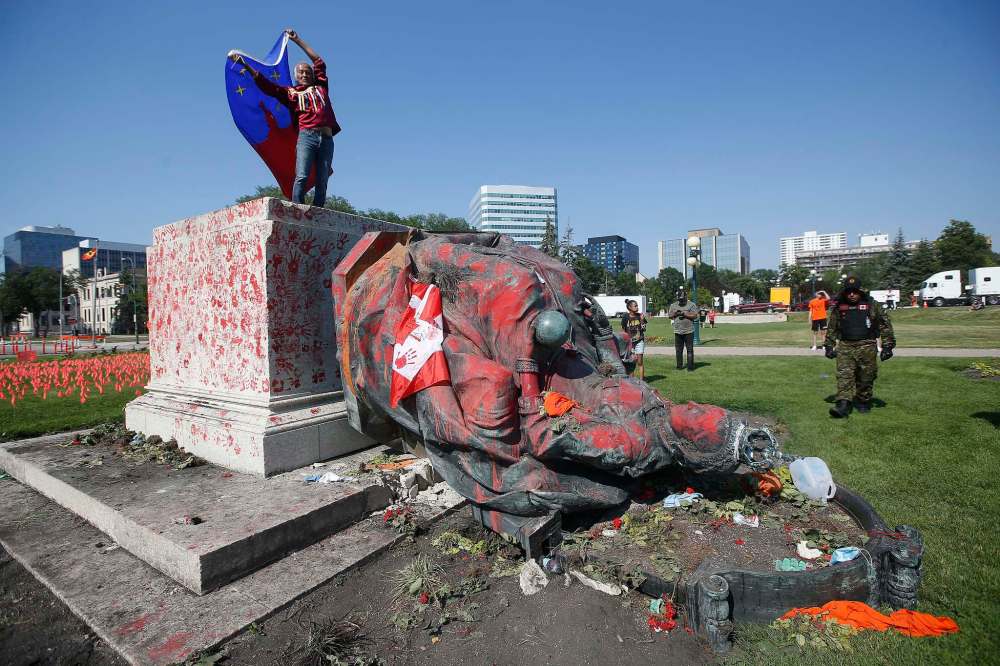
So if the premier wanted to speak about building, then this is where he ought to have begun: Indigenous peoples built things too, on lands that sustained their nations since time immemorial. They built homes, and communities, and cultures. They built trade networks that stretched to every corner of the continent.
And they built deep knowledge of the land and how to live on it, strategies that allowed them to thrive from the deserts to the tundra. They built families that passed all this knowledge from one generation to another. When Canada came to these lands, none of these things Indigenous people had built was seen to matter.
Instead, while those settlers Pallister commended on Wednesday were building, beginning to amass the wealth that would make Manitoba a prosperous and happy place for so many, Indigenous people were prevented even from leaving the reserves, which, under the pass system, had been made into open-air prisons.
“It takes a negative will to tear down,” Pallister said. “It takes a positive will to build up.”
Here, he was talking about statues. The words would better apply to residential schools, which for over a century deliberately tore down Indigenous cultures, families and lives. They would better apply to policies that denied full participation in the nation’s economic life and sought to sever Indigenous peoples’ self-determination.
This is the history from where we have come. It cannot now be undone.
But when Indigenous people stand up to call for an end to celebrating the figures and events that, by design, so damaged their communities, this is not an act of tearing down. It is, in fact, an invitation to consider a new future, one where, for the first time in this country’s history, we actually can build something better together.
Canada is a construction project, Pallister said, and in a way he’s right. Those who came here built many things, supported by a government and a system which prioritized their chance at affluence, their place on the land and their rights. And that construction came at a heavy cost to Indigenous health, and Indigenous life.
Reconciliation, in part, requires understanding that to go forward, to build better, then we must see the pain and that is part of that story too. In this way, a couple of toppled statues don’t stand in the way of reconciliation; what might is if we make so much noise about statues, that we close our ears to hearing the truth.
melissa.martin@freepress.mb.ca

Melissa Martin
Reporter-at-large
Melissa Martin reports and opines for the Winnipeg Free Press.
Our newsroom depends on a growing audience of readers to power our journalism. If you are not a paid reader, please consider becoming a subscriber.
Our newsroom depends on its audience of readers to power our journalism. Thank you for your support.
History
Updated on Thursday, July 8, 2021 8:02 PM CDT: Removes II from Queen Elizabeth
Updated on Friday, July 9, 2021 12:07 PM CDT: Fixes typo



